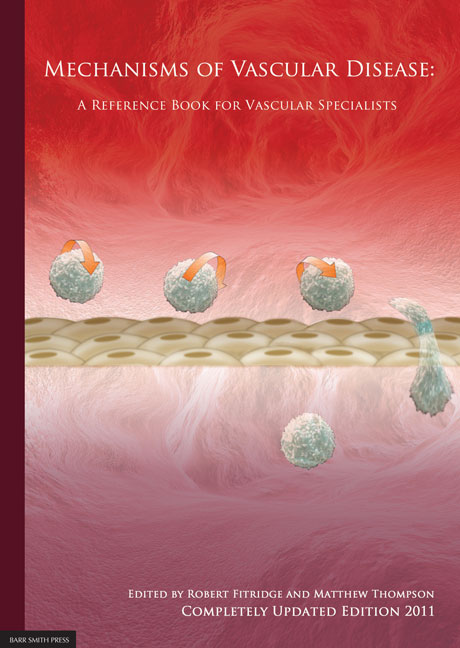Book contents
- Frontmatter
- Contents
- List of Contributors
- Detailed Contents
- Acknowledgements
- Abbreviation List
- 1 Endothelium
- 2 Vascular smooth muscle structure and function
- 3 Atherosclerosis
- 4 Mechanisms of plaque rupture
- 5 Current and emerging therapies in atheroprotection
- 6 Molecular approaches to revascularisation in peripheral vascular disease
- 7 Biology of restenosis and targets for intervention
- 8 Vascular arterial haemodynamics
- 9 Physiological Haemostasis
- 10 Hypercoagulable States
- 11 Platelets in the pathogenesis of vascular disease and their role as a therapeutic target
- 12 Pathogenesis of aortic aneurysms
- 13 Pharmacological treatment of aneurysms
- 14 Pathophysiology of Aortic dissection and connective tissue disorders
- 15 Biomarkers in vascular disease
- 16 Pathophysiology and principles of management of vasculitis and Raynaud's phenomenon
- 17 SIRS, sepsis and multiorgan failure
- 18 Pathophysiology of reperfusion injury
- 19 Compartment syndromes
- 20 Pathophysiology of pain
- 21 Post-amputation pain
- 22 Treatment of neuropathic pain
- 23 Principles of wound healing
- 24 Pathophysiology and principles of varicose veins
- 25 Chronic venous insufficiency and leg ulceration: Principles and vascular biology
- 26 Pathophysiology and principles of management of the diabetic foot
- 27 Lymphoedema – Principles, genetics and pathophysiology
- 28 Graft materials past and future
- 29 Pathophysiology of vascular graft infections
- Index
23 - Principles of wound healing
Published online by Cambridge University Press: 05 June 2012
- Frontmatter
- Contents
- List of Contributors
- Detailed Contents
- Acknowledgements
- Abbreviation List
- 1 Endothelium
- 2 Vascular smooth muscle structure and function
- 3 Atherosclerosis
- 4 Mechanisms of plaque rupture
- 5 Current and emerging therapies in atheroprotection
- 6 Molecular approaches to revascularisation in peripheral vascular disease
- 7 Biology of restenosis and targets for intervention
- 8 Vascular arterial haemodynamics
- 9 Physiological Haemostasis
- 10 Hypercoagulable States
- 11 Platelets in the pathogenesis of vascular disease and their role as a therapeutic target
- 12 Pathogenesis of aortic aneurysms
- 13 Pharmacological treatment of aneurysms
- 14 Pathophysiology of Aortic dissection and connective tissue disorders
- 15 Biomarkers in vascular disease
- 16 Pathophysiology and principles of management of vasculitis and Raynaud's phenomenon
- 17 SIRS, sepsis and multiorgan failure
- 18 Pathophysiology of reperfusion injury
- 19 Compartment syndromes
- 20 Pathophysiology of pain
- 21 Post-amputation pain
- 22 Treatment of neuropathic pain
- 23 Principles of wound healing
- 24 Pathophysiology and principles of varicose veins
- 25 Chronic venous insufficiency and leg ulceration: Principles and vascular biology
- 26 Pathophysiology and principles of management of the diabetic foot
- 27 Lymphoedema – Principles, genetics and pathophysiology
- 28 Graft materials past and future
- 29 Pathophysiology of vascular graft infections
- Index
Summary
INTRODUCTION
Acute wounds normally heal in an orderly and efficient manner, and progress smoothly through the four distinct, but overlapping phases of wound healing: haemostasis, inflammation, proliferation and remodelling (Figure 23.1). In contrast, chronic wounds will similarly begin the healing process, but will have prolonged inflammatory, proliferative, or remodelling phases, resulting in tissue fibrosis and in non-healing ulcers. The process of wound healing is complex and involves a variety of specialized cells, such as platelets, macrophages, fibroblasts, epithelial and endothelial cells. These cells interact with each other and with the extracellular matrix. In addition to the various cellular interactions, healing is also influenced by the action of proteins and glycoproteins, such as cytokines, chemokines, growth factors, inhibitors, and their receptors. Each stage of wound healing has certain milestones that must occur in order for normal healing to progress. In order to identify the differences inherent in chronic wounds that prevent healing, it is important to review the process of healing in normal wounds
PHASES OF ACUTE WOUND HEALING
Haemostasis
Haemostasis occurs immediately following an injury. To prevent exsanguination, vasoconstriction occurs and platelets undergo activation, adhesion and aggregation at the site of injury. Platelets become activated when exposed to extravascular collagen (such as type I collagen), which they detect via specific integrin receptors, cell surface receptors that mediate a cell's interactions with the extracellular matrix. Once in contact with collagen, platelets release the soluble mediators (growth factors and cyclic AMP) and adhesive glycoproteins, which signal them to become sticky and aggregate.
- Type
- Chapter
- Information
- Mechanisms of Vascular DiseaseA Reference Book for Vascular Specialists, pp. 423 - 450Publisher: The University of Adelaide PressPrint publication year: 2011
- 61
- Cited by



